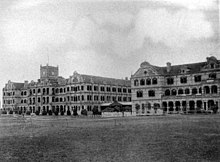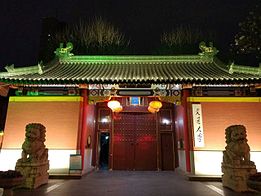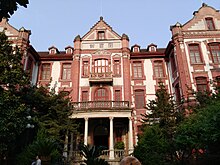Shanghai Jiao Tong University
上海交通大学 | |
 | |
Former names | Nanyang Public School Nan Yang College of Chiao Tung National Chiao Tung University Jiao Tong University |
|---|---|
| Motto | 饮水思源 爱国荣校[1] |
Motto in English | Gratitude and Responsibility.[2] |
| Type | Public |
| Established | 1896 |
| President | Lin Zhongqin |
| Party Secretary | Yang Zhenbin |
Academic staff | 3,061 |
| Undergraduates | 16,221[3] |
| Postgraduates | 14,532 Master Candidates 7,236 Ph.D. Candidates[4] |
| Location | Shanghai , China 31°12′03″N 121°25′47″E / 31.20083°N 121.42972°ECoordinates: 31°12′03″N 121°25′47″E / 31.20083°N 121.42972°E |
| Campus | Urban, 3.4 km2 |
| Affiliations | C9, Universitas 21, Project 985, Project 211 |
| Website | www |
| Shanghai Jiao Tong University | |||
|---|---|---|---|
| Simplified Chinese | 上海交通大学 | ||
| Traditional Chinese | 上海交通大學 | ||
| |||




Shanghai Jiao Tong University (SJTU; simplified Chinese: 上海交通大学; traditional Chinese: 上海交通大學) is a major research university in Shanghai. Established on April 8, 1896, as Nanyang Public School by an imperial edict issued by the Guangxu Emperor, it is one of China's oldest universities.[5][6] Shanghai Jiao Tong University is a C9 League university and a Chinese Ministry of Education Class A Double First Class University.[7]
In recent years, it consistently features in the world's top 100 universities as ranked by the Academic Ranking of World Universities, the QS World University Rankings, and the Times Higher Education World University Rankings.[8][9][10]
Name[]
The word "Jiao Tong" (交通), formerly romanized as "Chiao Tung", means transportation or communication. It reflects the university's root — it was founded by the Ministry of Posts and Communications of the late Qing dynasty.[citation needed] Jiao Tong or Chiao Tung could be translated as transport but it also means "extending in all directions". Engineering and managerial sciences are prioritized academic focuses, not the exclusive fields of research in Jiao Tong Universities.
History[]
This section needs additional citations for verification. (June 2021) |
In 1896, the Nanyang Public School (南洋公學) was founded in Shanghai by the imperial edict of the Guangxu Emperor, under the Business and Telegraphs Office of the Qing imperial government. Four schools were established: a normal school, a school of foreign studies, a middle school, and a high school. Sheng Xuanhuai, the mandarin who proposed the idea to the Guangxu Emperor, became the first president and is, along with missionary educator John Calvin Ferguson, regarded as the university's founder.
The Ministry of Commerce assumed administration of the college in 1904, and in 1905 changed the college's name to Imperial Polytechnic College of the Commerce Ministry. In 1906, the college was placed under the Ministry of Posts and Telegraphs. Its name was changed to Shanghai Industrial College of the Ministry of Posts and Telegraphs. When the Republic of China was founded, the college was placed under the Ministry of Communications and its name was once again changed, this time to Government Institute of Technology of the Communications Ministry.
In 1918, the Republic of China government founded the School of Management. After a merger with two other colleges in 1920, the name changed to Nan Yang College of Chiao Tung.
The college achieved world renown in the 1930s and was referred to as the "Eastern MIT".[11] In 1938, the Ministry of Education assumed administration of the university and renamed it to National Chiao Tung University (Chinese: 國立交通大學), the name by which daughter institution National Chiao Tung University in Taiwan is known to this day. In 1943, the graduate school was founded.
When the Japanese surrendered in 1945, neither the Communist Party of China (CPC) nor the Kuomintang KMT trusted each other or were actively cooperating. After American-sponsored attempts to negotiate a coalition government failed in 1946, the Chinese Civil War resumed. The CPC defeated the Nationalists in 1949, forcing Chiang's government to retreat to Taiwan. During the evacuation, a part of the faculty and alumni was taken to Taiwan by Chiang Kai-shek, founding National Chiao Tung University in Taiwan in 1958.
After the Chinese Civil War, the People's Republic of China was founded in 1949. Chiao Tung lost its "National" appellation and became Chiao Tung University to reflect that all universities under the new socialist state would be public.
In the 1950s, the pinyin romanization system was developed in Mainland China and Chiao Tung University changed its English name to Jiao Tong University.
Shanghai Second Medical University was merged into Shanghai Jiao Tong University on July 18, 2005, under the name Medical School of Shanghai Jiao Tong University.
Since the reform and opening-up policy in China, SJTU has grown substantially. It comprises five campuses, including Xuhui, Minhang, Luwan, Qibao, and Fahua (法华), taking up an area of about 3,225,833 square meters. [12]
In 2013, François Hollande inaugurated the SJTU-ParisTech Elite Institute of Technology (SPEIT), an institution based on the French engineering education system. The four founding member universities are École Polytechnique, ENSTA ParisTech, Mines ParisTech and Télécom ParisTech.[13]
The university was also a producer of the Academic Ranking of World Universities until 2008.
Academics, enrollment, and staff[]
This section needs additional citations for verification. (June 2021) |

Today SJTU has 31 schools (departments), 63 undergraduate programs, 250 masters-degree programs, 203 Ph.D. programs, 28 post-doctorate programs, and 11 state key laboratories and national engineering research centers.
Its total enrollment of students amounts to 40,711, of which 2,722 are international students. There are 16,221 undergraduates and 21,768 masters and Ph.D. candidates.[12]
The university has more than 1,900 professors and associate professors, including 22 academicians of the Chinese Academy of Sciences, 24 academicians of the Chinese Academy of Engineering, 139 accredited professors, and chair professors of the "Chang Jiang Scholars Program".
Reputation and rankings[]
| University rankings | |
|---|---|
| Global – Overall | |
| ARWU World[14] | 59 (2021) |
| QS World[15] | 50 (2022) |
| QS Employability[16] | 43 (2020) |
| THE World[17] | 84 (2022) |
| THE Reputation[18] | 51-60 (2020) |
| Regional – Overall | |
| QS Asia[19] | 10 (2021) |
| QS BRICS[20] | 7 (2019) |
| THE Asia[21] | 16 (2021) |
| THE Emerging Economies[22] | 5 (2021) |
| National – Overall | |
| BCUR National[23] | 4 (2022) |
Internationally, SJTU is ranked among 59th globally by ARWU (2021). The institution came seventh in the QS BRICS University Rankings[24] and sixth in the Emerging Economies University Rankings 2020 by Times Higher Education.[25] In 2020, it was ranked 37th among the universities around the world by SCImago Institutions Rankings.[26] Regarding research output, the Nature Index 2020 ranks the university 9th in China, 12th in the Asia-Pacific and 33rd in the world among the global academic universities.[27]
Academic Ranking of World Universities[]
Since 2003, Shanghai Jiao Tong University has produced the Academic Ranking of World Universities,[28] which analyzes the top universities in the world on quality of faculty (40%), research output (40%), quality of education (10%) and performance vs. size (10%).[29] Its ranking is exclusive of research universities, mainly in the empirical sciences.
Organization[]
This section needs additional citations for verification. (June 2021) |
Academic schools[]
- Continuing Education
- Biomedical Engineering
- Naval Architecture, Ocean and Civil Engineering
- Mechanical Engineering
- University of Michigan - Shanghai Jiao Tong University Joint Institute
- SJTU – ParisTech Elite Institute of Technology (SPEIT)
- China-UK Low Carbon College
- Electronic, Information and Electrical Engineering
- Materials Science and Engineering
- Sciences: Mathematics and Physics
- Life Science and biotechnology
- Shanghai Center for Systems Biomedicine
- Humanities
- Chemistry and Chemical Engineering
- Antai College of Economics and Management
- Finance and MBA
- International and Public Affairs
- Foreign Languages
- Agriculture and Biology
- Environmental Science and Engineering
- Pharmaceutics
- Medical
- Law
- Design
- Micro-electronics
- Information Security Engineering
- Software Engineering



Directly affiliated departments[]
- Department of Plastic Technology
- Department of Sports
Graduate school[]
- Global Executive MBA Program (In collaboration with the University of Southern California)
Affiliated institutes[]
- Institute of Aerospace Science and Technology
- Research Institute of Micro/Nano Science and Technology
- Institute of Energy
Affiliated hospitals[]
- CWI International Peace Maternity and Child Health Hospital
- Ruijin Hospital
- Renji Hospital
- Xinhua Hospital
- (zh)[30] (also translated as Shanghai First People's Hospital)
- Shanghai Sixth People's Hospital
- Shanghai Ninth People's Hospital
- Shanghai Third People's Hospital (Baosteel Hospital)
- Shanghai Children's Medical Center
- Shanghai Chest Hospital
- Shanghai Mental Health Center
- Shanghai Children's Hospital
Student organizations[]
SJTU Dancing Team[]
Diversified genres including Latin, Ballet, Chinese Folk Dance, Chinese Classical Dance and Yang Go.
- Awards: Second-class prize on National University Art Competition
Campuses[]
This section needs additional citations for verification. (June 2021) |
Xuhui Campus[]



The previous main campus was located in Xujiahui, in the Xuhui District of Shanghai, formerly a mostly Catholic area and a site of several educational institutions.

Most buildings on campus were influenced by American architecture. The main gate, built in 1935, is of traditional Chinese style reflecting the University's earlier status as the "Imperial Polytechnic College". he main gate approaches were via a series of marble bridges, similar to, although smaller than, those built in front of Tiananmen. However, recent road expansions have demolished the river as well as most bridges. A copy of this famous gate scene has been built on the east of the Minhang campus.
The construction of the campus never came to an end in the past century. Existing buildings: the Middle College building (built in 1898), the original library (built in 1919), the gymnasium (built in 1925), the administrative building (built in 1933), the Xinjian building (built in 1953), the new Upper College building (built in 1955), the second teaching building (built in 1960), Bao Zhaolong library (built in 1985) and Haoran high-tech building (built in 1996) were constructed one after another.
The university's School of International Education is located here, where many international students take classes throughout the academic year (however, most international students who take degree courses are in Minhang campus). The campus still houses various scientific research institutions, State Key Laboratory of Ocean Engineering, for instance, although most moved to the new campus since 1987.
Minhang Campus[]

The Minhang campus is located in the Minhang District on the outskirts of metropolitan Shanghai. This young campus, which was founded in 1987, covers 2,822,903m2 once farmland. Zizhu Science Park, where Intel, ST Microelectronics, Microsoft, Sandisk, and other high-tech companies placed their research and development centers, south of this campus.
Currently, most of the university's administrative and academic framework and the majority of undergraduate and graduate students are situated at this campus, and the campus has three libraries and seven dining halls.
South Chongqing Road Campus[]
It used to be the campus of Shanghai Second Medical University, which is located in the Luwan District of Shanghai. The Aurora University (Shanghai), a pre-eminent Catholic university in Shanghai, was located there before 1952.
Qibao Campus[]
In 1999, Shanghai Agricultural College was merged into SJTU. Its campus, located at 2678 Qixin Road (postcode 201101), became the Qibao Campus of SJTU.
Shangzhong Road Campus[]
In 2006, Shanghai Jiao Tong University sold this campus to Shanghai High School.
Fahuazhen Road Campus[]
This campus is where Jiao Tong's Antai College of Economics and Management and the School of Continuing Education are located.
Lingang Campus[]
This campus is located at No 3 Yinlian Rd in the Lingang area. Jiao Tong's China-UK Low Carbon College moved to this campus in Step. 2018.
Notable alumni[]
This section needs additional citations for verification. (June 2021) |
Today, associations organized by Jiao Tong's alumni can be found in the United States, Japan, European Union countries, Canada, Southeast Asia, Taiwan, Hong Kong and Mainland China. They call themselves Jiao Tong (Jiaoda) people.
The routine services of these alumni associations include: updating contact lists, holding conferences, conducting Sino-foreign cultural exchanges, and keeping contact with other alumni associations throughout the world.
Students from SJTU have won top prizes in various competitions, including ACM International Collegiate Programming Contest, International Mathematical Contest in Modeling and Electronics Design Contests. Famous alumni of SJTU or its predecessors include former Chinese Communist Party (CCP) general secretary Jiang Zemin, former Shanghai Mayor Wang Daohan, former CCP Politburo member Ding Guangen, former National People's Congress Vice Chairman Huang Yanpei, former Warlord Cai Er, National People's Congress Vice Chairman Chen Zhu, Aerospace engineer Qian Xuesen, Economist Mao Yushi, Mathematician Wu Wenjun, former National People's Congress Vice Chairman Yan Junqi, Hainan Communist Party Secretary Shen Xiaoming, Lenovo Chairman Yang Yuanqing and many more. More than 200 of the academicians of the Chinese Academy of Sciences and Chinese Academy of Engineering are alumni of Jiao Tong University.
See also[]
- National Jiaotong University
References[]
- ^ 校训. Archived from the original on 2018-03-17. Retrieved 2014-07-10.
- ^ "SJTU 2011 Undergraduate Commencement Ceremony". 2011-06-25. Archived from the original on 2016-12-20.
- ^ "2017–12-31 Overview (Undergraduate)" (PDF). Shanghai Jiao Tong University. Retrieved 2019-06-10.
- ^ "2017–12-31 Overview (Postgraduate)". Shanghai Jiao Tong University. Retrieved 2019-06-10.
- ^ Sullivan, Lawrence R.; Liu, Nancy Y. (2015). Historical Dictionary of Science and Technology in Modern China. London: Rowman and Littlefield. p. 375.
- ^ Linehan, Paul Michael (2018). The Culture of Leadership in Contemporary China: Conflict, Values, and Perspectives for a New Generation. London: Lexington Books. p. 128.
- ^ 教育部 财政部 国家发展改革委 关于公布世界一流大学和一流学科建设高校及建设 学科名单的通知 (Notice from the Ministry of Education and other national governmental departments announcing the list of double first-class universities and disciplines).
- ^ "QS World University Rankings 2021".
- ^ "World University Rankings 2021". Times Higher Education.
- ^ "Academic Ranking of World Universities 2020". Shanghai Ranking Consultancy.
- ^ "During the last century: Eastern MIT". Xi'an Jiao Tong University. Archived from the original on 2007-10-16. Retrieved 2007-06-19.
- ^ Jump up to: a b "About SJTU - Overview". 2017-12-31. Retrieved 2019-06-10.
- ^ Overview Archived 2014-10-06 at the Wayback Machine, SJTU-ParisTech Elite Institute of Technology
- ^ "ARWU World University Rankings 2020 | Academic Ranking of World Universities 2021 | Top 1000 universities | Shanghai Ranking - 2021". www.shanghairanking.com.
- ^ "QS World University Rankings 2021". Top Universities. February 1, 2017.
- ^ "QS Graduate Employability Rankings 2019". Top Universities. February 1, 2017.
- ^ "World University Rankings 2022". Times Higher Education (THE). September 2, 2021.
- ^ "THE Reputation World University Rankings 2020". Retrieved 27 November 2020.
- ^ "QS University Rankings: Asia 2021". Retrieved 27 November 2020.
- ^ "QS University Rankings: BRICS 2018". Top Universities. February 1, 2017.
- ^ "THE Asia University Rankings 2021". Retrieved 5 June 2021.
- ^ "THE Emerging University Rankings 2021". Retrieved 26 April 2021.
- ^ "Overall Ranking, Best Chinese Universities Rankings - 2019". www.shanghairanking.com.
- ^ "QS University Rankings: BRICS". Quacquarelli Symonds. 2013-12-17. Archived from the original on 2013-12-17. Retrieved 2013-12-17.
- ^ "BRICS & Emerging Economies Rankings 2014". Times Higher Education. Archived from the original on August 12, 2014. Retrieved October 2, 2014.
- ^ "SCImago Institutions Rankings - Higher Education - All Regions and Countries - 2020 - Overall Rank". www.scimagoir.com.
- ^ "2020 tables: Institutions - academic | 2020 tables | Institutions - academic | Nature Index". www.natureindex.com. Retrieved 2021-02-27.
- ^ Academic Ranking of World Universities - 2007 Archived 2007-08-24 at the Wayback Machine
- ^ ADRW2007-Methodology Archived 2008-01-09 at the Wayback Machine
- ^ "上海市第一人民医院——首页". www.firsthospital.cn.
External links[]
| Wikimedia Commons has media related to Shanghai Jiao Tong University. |
- Official website (in English)
- Shanghai Jiao Tong University
- Project 211
- Project 985
- Plan 111
- Educational institutions established in 1896
- Jiaotong University
- 1896 establishments in China
- C9 League
- Vice-ministerial universities in China
- Xuhui District


